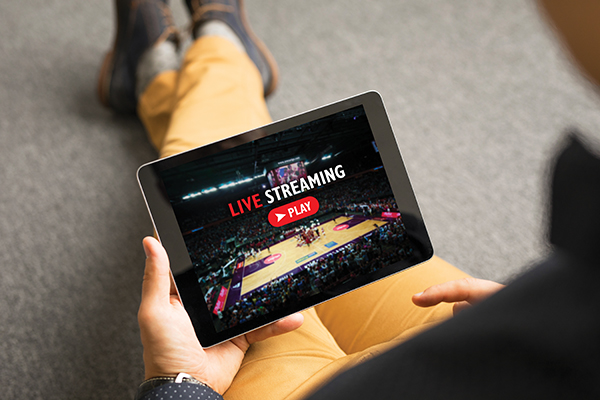
In 2021, thousands of people put feet to pavement and competed in the nation’s most celebrated marathons. And while, in many cases, they did not leave their neighborhood, their times were logged, and they were included among the list of people who completed these grueling competitions.
The COVID-19 pandemic has profoundly changed how we participate in and enjoy sports. As games, leagues, tournaments, group workouts, and nearly every public activity imaginable came to a halt, a new type of event emerged. Hybrid sports events are activities that allow for both at home and in person participation. The hybrid event model can be applied to any level of competition from fitness classes and sports camps to professional sports.
How Hybrid Sports Events Became So Popular

While people longed for the time when they could return to the movies or concert festivals, their love for sport, both as a participant and a fan, burned brightest. According to the running apparel seller RunRepeat, during the first five months of the pandemic (March-August 2020), health and fitness content viewership increased 1,300 percent.
Concurrently, a bevy of technological advances have paved the way for people to participate or enjoy sports from nearly anywhere. Video conferencing tools are allowing people to take part in workouts from the comfort of their living rooms. Streaming technology is allowing us to catch all games, whether it’s the Knicks at the Garden or a Halo Lax tournament at the Hoover Met Complex, without being in attendance. Virtual reality headsets are taking fans to the infield of the Kentucky Derby.
Desire plus technological advancement fuel another driver of hybrid events, convenience. “People want in-person (events), but if given the option to be virtual, they will take it. It’s not about safety as much as it is about the kid’s soccer game on Saturday or a torrential rain storm on race day,” said John Mortimer, the founder and owner of Millennium Running, which operates over 30 races across the country. They introduced virtual running events in 2020 to recoup revenue lost when all of their in-person events were shut down.
Why Hybrid Events are Important, Even After the Pandemic
Even with the return of in-person events, there are several key reasons why some event rights holders continue to offer virtual alternatives.
Hybrid Sports Offer Connection
At a time when we needed it the most, virtual sports and recreation connected athletes and fans around a common interest. This can be seen in esports, which enjoyed a meteoric rise during the COVID-19 pandemic. Whether you watched a League of Legends tournament or competed with friends, you were connected to a community of gamers around the world that not only practiced and competed, but also shared strategies and talked about the stars of the sport.
Hybrid Sports Promote Inclusivity
No longer is event participation limited by geography or financial status. The Peachtree Road Race in Atlanta is one of America’s largest running events. The 10K race runs through some of Atlanta’s most prestigious neighborhoods during the Independence Day holiday. While not everyone has the time or the financial resources to get to Atlanta, they can now take advantage of the virtual option and receive the same race bib and finisher’s T-shirt.
Hybrid Events Increase Exposure to Certain Sports
The sport of lacrosse has increased dramatically in popularity over the last decade. 6on6 lax, a subset of the sport, is gaining popularity as well. HaloLax, a lacrosse event company, is doing their part to grow the sport, by not only hosting events throughout the country, but by streaming the action for families, fans, and recruiters that aren’t in attendance.
Hybrid Event Types
As we head out of the pandemic, the hybrid versions of in-person events represent an opportunity to engage a larger group of consumers in exciting ways. Below are three hybrid event types, along with examples and what can be learned from each event.
Competing Virtually in Live, In-Person Events
The most standard version of the hybrid event involves an in-person competition that athletes participate in virtually. In road and trail racing, participants register for events. Then on race day or during a designated period, they time themselves while running the race distance in their home location. After the run, they can submit the time to the race organizer and receive the official race medal and t-shirt.
While many races use this strategy, RunDisney goes one step further. RunDisney uses the same themes for virtual races that you’d see in their in-person events. The 2022 theme is based on the movie Frozen. Not only will it be reflected in the race medal and bib, but runners can also download a special Frozen playlist from Walt Disney Records to accompany them on their run.
Lesson Learned: While virtual components of live events allow people to participate from anywhere, it can feels disconnected from the live experience. Adapting a theme for virtual participants engages this group and strengthens their tie to your event.
Virtual-Only Events
Some events only exist virtually and serve as a way for people from around the world to compete. FishDonkey is an app that allows fishermen to compete in tournaments for monetary prizes. Anglers enter tournaments for a small fee (organizing a tournament is free). Through the duration of the tournament time, participants may go to their local body of water and catch fish. Once they’ve caught their specimen, they must take a picture or video of it, measure it, enter the species on the app, and submit the information. A virtual leaderboard helps competitors keep track of their progress in the standings. Once the tournament ends, the winner is determined, and prize money is distributed.
Lesson Learned: Tools like apps and video works well for sports in which judges determine the outcome. Cheerleading event organizer Varsity Sprit hosts virtual cheer competitions in which teams send in videos of designated routines through the CheerMatch app. These routines are evaluated by a group of judges who determine a winner. Dance and fitness competitions, and even ice skating, can use this same model.
Virtual Training
Video conferencing technologies such as Zoom and Microsoft Teams allow participants to work with a trainer from anywhere in the world. While we were already seeing this model through tools like Peloton, the pandemic drove the rise of virtual workouts in nearly every discipline.
Camp Gladiator, a company that organizes group strength and cardiovascular workouts, quickly pivoted to virtual workouts during the pandemic. Camp Gladiator subscribers join classes with instructors, regardless of location, for a 45-to 60-minute workout. Even as they’ve returned to in-person workouts, there are many virtual classes still available.
Lesson Learned: Any venue or event operator can employ this strategy using social media. Cedar Point Sports Center, an award-winning youth sports complex in Sandusky, Ohio, provided a virtual “drill of the day” on their Facebook page in 2020. The video series provided viewers with easy tips to improve their basketball and volleyball skills. The series not only gave young viewers an activity during this time, but it kept the facility top of mind despite being closed due to state policies during the COVID-19 pandemic.
While the desire for in-person events is not likely to be replaced, hybrid events are carving out their own place in youth and professional sports as well as in the fitness industry. Convenience and affordability are driving consumer interest beyond the COVID-19 pandemic. Event organizers are seeing strong benefits as well. According to John Mortimer of Millennium Racing, since introducing a virtual component to his races, the percentage of people who register but don’t compete has reduced from 14 to 4 percent. With hybrid events’ ability to drive both business success and consumer satisfaction, it’s likely that its share of the market will only grow in the coming years. SDM

